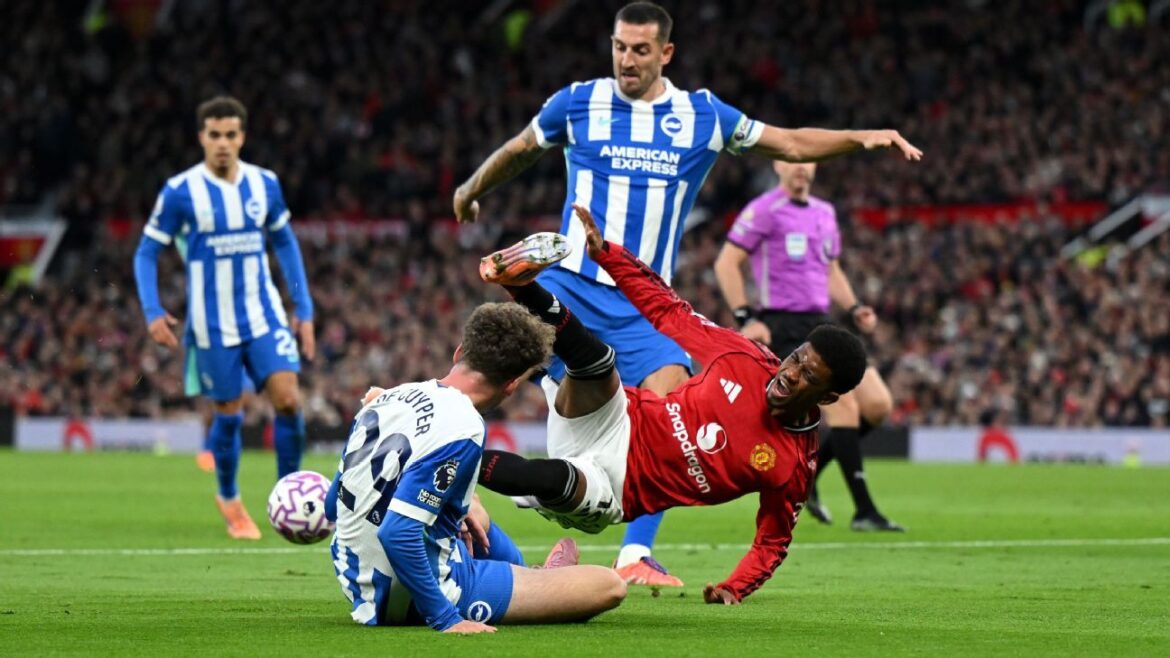Video Assistant Referee causes controversy every week in the Premier League, but how are decisions made and are they correct?
This season, we take a look at the major incidents, to examine and explain the process both in terms of VAR protocol and the Laws of the Game.
Andy Davies is a former Select Group referee, with over 12 seasons on the elite list, working across the Premier League and Championship. With extensive experience at the elite level, he has operated within the VAR space on Premier League and offers a unique insight into the processes, rationale and protocols that are delivered on a Premier League matchday. @andydaviesref
Referee: Anthony Taylor
VAR: Michael Oliver
Incident: Penalty appeal for Manchester United
Time: 15th minute
What happened: Amad Diallo ran into the Brighton area, drawing Maxim De Cuyper into making a challenge. As Diallo cut back inside the defender, De Cuyper flicked out his right leg to seemingly trip the Manchester United attacker. Referee Taylor was unmoved by the appeals and allowed play to continue.
VAR Decision: Having viewed the incident, the VAR checked and completed the non-penalty award. Oliver cited that De Cuyper had touched the ball while challenging and agreed with the on-field decision of no penalty.
VAR Review: “Clear and obvious” errors are the benchmark for a VAR intervention and Oliver, having viewed the various angles, would have felt this event did not meet the criteria required. Oliver communicated in his review process that he was happy that De Cuyper made a touch on the ball while putting in the challenge and was therefore comfortable with the original on-field decision.
#MUNBHA – 15′
The referee’s call of no penalty to Manchester United was checked and confirmed by VAR – with it deemed that De Cuyper played the ball.
— Premier League Match Centre (@PLMatchCentre) October 25, 2025
Verdict: An interesting situation and another penalty decision where a “touch on the ball” seems to have been a key factor as to whether an adjudged foul has been committed or not. Manchester United vs. Chelsea (Robert Sánchez), Newcastle vs. Arsenal (Nick Pope), and Fulham vs. Arsenal (Kevin) are three other incidents like this that have occurred in recent weeks.
A touch on the ball should not always negate that a foul challenge has been committed and, though I agree with all three of these previous decisions given their circumstances and individual context, I believe Taylor was incorrect on this occasion and should have awarded a penalty.
This was not a challenge for the ball by De Cuyper, it was a lazy attempt to trip his opponent; any touch on the ball was minimal and consequential of his careless action, as opposed to a measured challenge.
However, once Taylor chose not to award the penalty, the decision should not have instigated an on-field review by VAR as it was not a “clear and obvious” error. The decision was subjective and live communication from Taylor would have matched the pictures in the VAR hub.
1:53
Moreno: Man United have developed an aura of confidence
Alejandro Moreno reacts to Manchester United’s 4-2 win vs. Brighton in the Premier League.
Incident: Possible foul by Luke Shaw on Georginio Rutter.
Time: 61st minute
What happened: Bryan Mbeumo scored United’s third goal after Brighton lost possession in the center of the pitch. But Brighton felt aggrieved that there had been a holding offence committed on Rutter by Shaw in the buildup to the goal. Referee Taylor had a good view of the incident and didn’t feel it met his threshold for a holding offence against the criteria set by him or the Premier League match officials.
VAR Decision: As with all goals, VAR checks all phases of play leading to a goal being scored, checking for any infringements clearly missed by the match officials in real time. The contact by Shaw on Rutter was certainly reviewed and it was felt that the on-field decision to allow play to continue was the correct outcome given the hold was minimal, not sustained and did not directly impact Rutter’s ability to continue to play.
VAR Review: Communication from the referee in real time would have created the framework for this VAR check for a possible foul. Taylor had a great view and his communication would have explained that he had seen a hold by Shaw, however it was not sustained enough or impactful on Rutter’s ability to play and he was comfortable no offence had been committed.
For VAR to intervene in this type of event, they would need to have seen clear evidence that Taylor’s reading of the incident was not factual against the pictures presented.
Verdict: Despite Brighton’s frustrations, this was a good decision in real time by Taylor and an equally a positive non-intervention by Oliver.
To penalize a player for a holding offence in this key area of the field of play, the refereeing team are looking for the action to meet one of the following criteria for it to be deemed a foul: is the hold sustained, impactful or extreme?
In this event there was a minimal, fleeting hold by Shaw that had very little impact on Rutter’s ability to continue with play. It was, in fact, Rutter’s decision to stop, as he was expecting a free kick to be awarded.
It is so important to watch these types of situations in “real time.” A still picture will show the holding to a point where you would question how can this not be a holding offence? However, in real time, you can clearly see the level of holding by Shaw was minimal and, in my opinion, just “normal football contact.” Indeed, this would have been the wording used by both Taylor and Oliver to conclude the incident.
